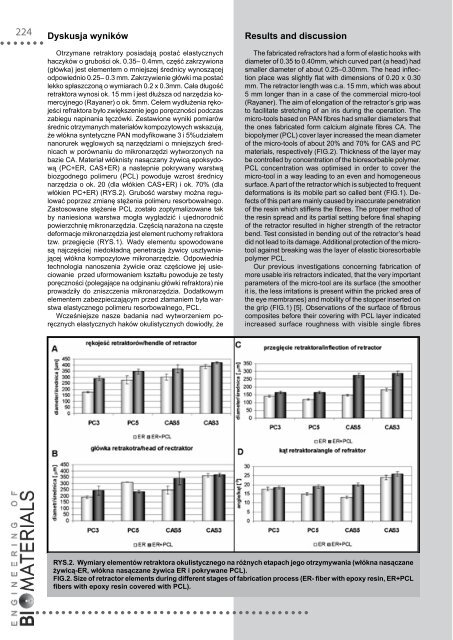89-91 - Polskie Stowarzyszenie Biomateriałów
89-91 - Polskie Stowarzyszenie Biomateriałów
89-91 - Polskie Stowarzyszenie Biomateriałów
Create successful ePaper yourself
Turn your PDF publications into a flip-book with our unique Google optimized e-Paper software.
224 dyskusja wyników<br />
Otrzymane retraktory posiadają postać elastycznych<br />
haczyków o grubości ok. 0.35– 0.4mm, część zakrzywiona<br />
(główka) jest elementem o mniejszej średnicy wynoszącej<br />
odpowiednio 0.25– 0.3 mm. Zakrzywienie główki ma postać<br />
lekko spłaszczoną o wymiarach 0.2 x 0.3mm. Cała długość<br />
retraktora wynosi ok. 15 mm i jest dłuższa od narzędzia komercyjnego<br />
(Rayaner) o ok. 5mm. Celem wydłużenia rękojeści<br />
refraktora było zwiększenie jego poręczności podczas<br />
zabiegu napinania tęczówki. Zestawione wyniki pomiarów<br />
średnic otrzymanych materiałów kompozytowych wskazują,<br />
że włókna syntetyczne PAN modyfikowane 3 i 5%udziałem<br />
nanorurek węglowych są narzędziami o mniejszych średnicach<br />
w porównaniu do mikronarzędzi wytworzonych na<br />
bazie CA. Materiał włóknisty nasączany żywicą epoksydową<br />
(PC+ER, CAS+ER) a nastepnie pokrywany warstwą<br />
biozgodnego polimeru (PCL) powoduje wzrost średnicy<br />
narzędzia o ok. 20 (dla włókien CAS+ER) i ok. 70% (dla<br />
włókien PC+ER) (RyS.2). Grubość warstwy można regulować<br />
poprzez zmianę stężenia polimeru resorbowalnego.<br />
Zastosowane stężenie PCL zostało zoptymalizowane tak<br />
by naniesiona warstwa mogła wygładzić i ujednorodnić<br />
powierzchnię mikronarzędzia. Częścią narażona na częste<br />
deformacje mikronarzędzia jest element ruchomy refraktora<br />
tzw. przegięcie (RyS.1). Wady elementu spowodowane<br />
są najczęściej niedokładną penetracja żywicy usztywniającej<br />
włókna kompozytowe mikronarzędzie. Odpowiednia<br />
technologia nanoszenia żywicie oraz częściowe jej usieciowanie<br />
przed uformowaniem kształtu powoduje ze testy<br />
poręczności (polegające na odginaniu główki refraktora) nie<br />
prowadziły do zniszczenia mikronarzędzia. Dodatkowym<br />
elementem zabezpieczającym przed złamaniem była warstwa<br />
elastycznego polimeru resorbowalnego, PCL.<br />
Wcześniejsze nasze badania nad wytworzeniem poręcznych<br />
elastycznych haków okulistycznych dowiodły, że<br />
results and discussion<br />
The fabricated refractors had a form of elastic hooks with<br />
diameter of 0.35 to 0.40mm, which curved part (a head) had<br />
smaller diameter of about 0.25–0.30mm. The head inflection<br />
place was slightly flat with dimensions of 0.20 x 0.30<br />
mm. The retractor length was c.a. 15 mm, which was about<br />
5 mm longer than in a case of the commercial micro-tool<br />
(Rayaner). The aim of elongation of the retractor’s grip was<br />
to facilitate stretching of an iris during the operation. The<br />
micro-tools based on PAN fibres had smaller diameters that<br />
the ones fabricated form calcium alginate fibres CA. The<br />
biopolymer (PCL) cover layer increased the mean diameter<br />
of the micro-tools of about 20% and 70% for CAS and PC<br />
materials, respectively (FIG.2). Thickness of the layer may<br />
be controlled by concentration of the bioresorbable polymer.<br />
PCL concentration was optimised in order to cover the<br />
micro-tool in a way leading to an even and homogeneous<br />
surface. A part of the retractor which is subjected to frequent<br />
deformations is its mobile part so called bent (FIG.1). Defects<br />
of this part are mainly caused by inaccurate penetration<br />
of the resin which stiffens the fibres. The proper method of<br />
the resin spread and its partial setting before final shaping<br />
of the retractor resulted in higher strength of the retractor<br />
bend. Test consisted in bending out of the retractor’s head<br />
did not lead to its damage. Additional protection of the microtool<br />
against breaking was the layer of elastic bioresorbable<br />
polymer PCL.<br />
Our previous investigations concerning fabrication of<br />
more usable iris retractors indicated, that the very important<br />
parameters of the micro-tool are its surface (the smoother<br />
it is, the less irritations is present within the pricked area of<br />
the eye membranes) and mobility of the stopper inserted on<br />
the grip (FIG.1) [5]. Observations of the surface of fibrous<br />
composites before their covering with PCL layer indicated<br />
increased surface roughness with visible single fibres<br />
rys.2. wymiary elementów retraktora okulistycznego na różnych etapach jego otrzymywania (włókna nasączane<br />
żywicą-er, włókna nasączane żywica er i pokrywane Pcl).<br />
FiG.2. size of retractor elements during different stages of fabrication process (er- fiber with epoxy resin, er+Pcl<br />
fibers with epoxy resin covered with Pcl).













